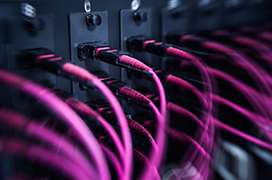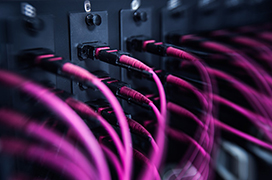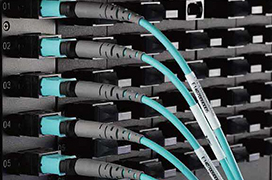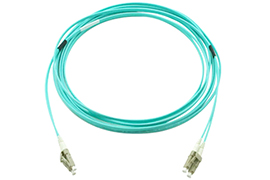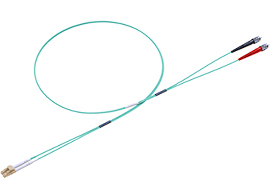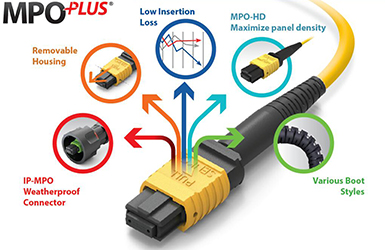
 2023.11.23
2023.11.23When it comes to the fiber connector world, it’s easy to get confused about the various types and their applications. That is the reason why I am writing this guide here. I have gathered information from all across to assist you in understanding everything about it.
After reading this guide, you will understand the following:
Table of Contents
· What is fiber connector?
· SC connector
· LC connector
· FC connector
· ST connector
· MPO connector
· MTP connector
· MT-RJ connector
· MU connector
· E2000 connector
· MDC connector
· CS connector
· SN connector
· DIN connector
· D4 connector
· ESCON connector
· FDDI connector
· SMA connector
· Non-Contact Fiber Connector
· How to choose?
What is Fiber Connector?
The fiber connector is also called fiber optic connector or optical fiber connector. It is a precise coupling device to join fiber optic cables quickly, enabling fast connection and disconnection than splicing. The connector mechanically orients the fiber cores, allowing light to pass and travel through the cable without interruption.
Unlike electrical connectors, the fiber optic connector allows light signals instead of electrical signals. That requires the connector must be much more precise. They are low insert loss, best insertion repeatability, high return loss, and long lifetime.
Although the manufacturers have launched over 100 fiber connectors, only a few types are the most popular and widely used in the industry. Next, we will talk about the main types of fiber optic connectors.
SC Connector
The SC (Standard Connector, Subscriber Connector) is a fiber optic connector released by the NTT in the mid-1980s. The connector is a snap-on square connector with a simple push-pull motion, similar to the push-pull latching mechanism of ordinary audio and video cables. It uses a 2.5mm diameter ferrule, twice the size of the later-developed LC connector.
Initially used in Gigabit Ethernet networks, the SC connector was adopted by the TIA-568-A specification in 1991. It has slowly gained popularity as manufacturing costs have decreased. Due to its outstanding performance, it has dominated the fiber optic field for more than decades. Still, In today’s fiber optic networks, SC connectors are among the two most common fiber optic connectors.
Due to the larger size of this connector, which requires more space for the same number of ports, it has slowly been replaced by more modern, streamlined connectors, such as LC and MPO connectors.
LC Connector
LC stands for “Lucent Connector”. Like the name, it was developed by Lucent Technologies. The LC connector has a 1.25mm ferrule, which is half the size of the SC. This small form-factor connector is extremely popular in datacoms and is perfect for high-density applications. Nowadays, many people prefer high-efficiency cabling with LC fiber optic connectors. It is currently the most often used and successful one.
Modern optical transceivers and active networking components feature LC connectors, expanding massive deployments and applications.
FC Connector
FC stands for “ferrule connector”. It is the first fiber optic connector to use a ceramic ferrule. However, unlike the plastic-bodied SC and LC, it uses a circular screw-type fitting made of nickel-plated or stainless steel. The end face of the FC fiber optic connector is inserted using an alignment key and then screwed into the adapter/jack using a fiber collet. Despite the added complexity of manufacturing and installation, FC connectors still offer options for precision instruments such as OTDRs. In addition, FC’s screw-in collet is ideal for application scenarios in high-vibration environments because it ensures a solid fit with a spring-loaded collar.
It was initially designed for data center and telecom applications, but its use has declined since the advent of SC and LC fiber optic connectors. That is because it costs more, and the connection speed is slower than the SC and LC.
ST Connector
AT&T developed and licensed the ST (Straight Tip) fiber connector shortly after introducing the FC type. It features a bayonet mount and a long cylindrical 2.5mm ceramic ferrule to retain the fiber. Because ST is spring-loaded, you must ensure that they are correctly seated. If you have a lot of loss, reconnect them to see if it helps.
ST connectors are commonly suitable for long-distance and short-distance applications, such as campuses and developing multimode fiber applications, enterprise networks, and military applications.
MPO Connector
MPO stands for Multi-fiber push-on connector. Unlike the conventional fiber connector, an MPO connector includes a fiber array that supports multiple fibers up to 12, 24, or 36 strands. Due to complexity, the Multi-fiber connectors are not yet suitable for field-fit applications and must be factory terminated. It is widely used in high-density data center or fiber cabling system that requires space-saving.
Although the total cabling pricing is much higher than standard LC or SC, MPO fiber optic connector provides significantly fast deployment and inexpensive cost based on a ”per-fiber” basis.
MTP Connector
MTP® is a registered trademark of US Conec. It is an abbreviation for Multi-fiber Termination Push-on. Compared with MPO, the MTP connector is an enhanced version of the Multi-fiber connector with improved accuracy, proven dependability, and better performance. Of course, its pricing is higher than the standard MPO.
MT-RJ Connector
MT-RJ stands for Mechanical Transfer Registered Jack. It is a duplex connector with female and male variants employing alignment pins. Currently, it is almost no longer in use. Specific systems, however, may still require these connectors for maintenance. MT-RJ is only compatible with multimode duplex cables. Both fibers enter the ferrule, connected to its mated half via pins and holes, much like MPO/MTP connector.
MU Connector
The MU (Miniature Unit Coupling) connector was developed by NTT, just like the Mini-SC. But unlike the SC, the MU connector has a 1.25mm zirconia ferrule. It uses a simple push-pull design, a compact miniature body, and a self-holding mechanism for backplane applications.
E2000 Connector
Diamond SA develops the E2000 connector. Also referred to as an LSH connector, it features a spring-loaded shutter mechanism to protect the ferrule end-face from dust and laser beams. The E2000 fiber optic connector has a one-piece design for easy and quick termination and is suited for high safety and power applications.
MDC Connector
Short for Miniature Duplex Connector, the MDC connector is created by US Conec. It is a Push-Pull-Boot duplex fiber connector using industry-standard 1.25mm ferrule while providing three times the density of LC connectors. As part of the Very Small Form Factor (VSFF) connectors portfolio, it targets SFP-DD, QSFP-DD, OSFP transceivers, and other high-density patching applications.
CS Connector
The CS connector is a new high-density, very small form factor (VSFF) fiber optic connector for QSFP-DD, OSFP, and COBO transceivers. Compared to an LC duplex, it delivers a 40% size reduction and doubles the density of patch panels.
SN Connector
The SN connector is a new duplex fiber optic connector developed by SENKO. Delivering higher density than the CS connector, the SN connector uses the industry-standard 1.25mm ferrule but reduced ferrule pitch; therefore offers a 4x duplex fiber connector with the same LC size. It is ideal for next-generation hyperscale data centers, Edge, Enterprise, or co-location DCI.
DIN Connector
DIN stands for Deutsches Institut für Normung, or German Institute for Standardization, a German manufacturing industry standards body. DIN connector is the fiber optic connector compatible with DIN 47256. These fiber connectors are rare, and very few users are in the market.
D4 Connector
The D4 connector is an older generation single mode fiber optic connector developed by NEC. It was most likely the first connector to use ceramic ferrules. This connector has a thinner ferrule than SCs or FCs. It was widely used in telecom networks from the 1980s through the early 1990s, and part of it may still be in use today.
ESCON Connector
IBM developed Enterprise Systems Connection (ESCON) in the early 1990s as a serial half-duplex optical fiber interface to improve connectivity by incorporating fiber optics into a network. The ESCON fiber optic connector uses 2.5mm ferrules, so they can mate with SC or ST connectors via fiber adapters. But to this day, ESCON is now being displaced by the industry’s newer and more efficient SC and LC connectors.
FDDI Connector
FDDI is an abbreviation for Fiber Distributed Data Interface, which refers to a local area networks technology such as Ethernet or Token Ring. Like the ESCON connector, the FDDI connector, also known as a MIC (Media Interface Connector) connector, is the termination on the fiber optic cable itself. It has two ferrules in a huge, heavy plastic housing with a squeeze-tab retention mechanism.
SMA Connector
SMA is the acronym for “Subminiature A,” Amphenol creates in the late 1970s. The ferrule of the model SMA was precisely 1/8 inch in diameter and mated in a machined adaptor. When the adapters were not accurate enough for superior fiber performance, a necked-down ferrule coupled with a Delrin adapter was used. Because of their key drawbacks, the SMA fiber connector is a commonly used multimode fiber but has a very tiny market share. We can only see them in minimal applications such as medical, materials processing, spectroscopy, sensing, and quality inspection.
Non-Contact Fiber Connector
We also see some enterprises develop non-contact fiber connectors.
Unlike the regular fiber optic connector, the non-contact fiber connector doesn’t require physical contact between the fiber end-face or a beam-forming lens. Thereby achieving lower insertion loss, improved return loss, assured random mating, and dust and dirt immunity. However, this new style connector has barely been deployed because of the much higher cost and manufacturing complexity.
How to Choose a Fiber Connector?
Still, trying to figure out how to choose the correct fiber optic connector? Check the following helpful steps.
Step 1: Know the fiber count and connector type
Choose the connector type based on your existing equipment and long-term plans. If you are using the most common SFP module, then select LC connector. If you use a QSFP28 module, you may choose MPO or LC connector. SC and LC are the most common choices, MPO is for high throughput data centers, and VSSF connectors such as CS and SN are for 400G and beyond fiber cabling applications.
Step 2: Know the fiber type
Like fiber cable, fiber optic connectors can be commonly categorized into single mode and multimode. Single mode fiber permits one light mode to propagate simultaneously, offering the longest transmission distance. The multimode allows many light modes to propagate through the fiber, supporting a very short distance but lowering cabling costs.
Those fiber connectors usually have different color codes for easy identification. Single mode connectors typically have blue or green covers, while OM1/OM2 multimode connectors have beige covers, OM3 has auqa color, and OM4 with magenta color.
Step 3: Know the polish type
Remember the polish type. Fiber optic connectors are available in PC, UPC, and APC polish. Different polish offers performance and the cost difference. Check them with your supplier before ordering.



